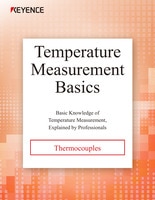Temperature Measurement Glossary
This section explains terms used in temperature measurement.
Blackbody
An object that completely absorbs electromagnetic waves at all wavelengths, not limited to visible light, without reflecting them and can emit heat as well. It is also called a perfect radiator.
Comparison method
A method that uses a comparison device, such as a constant temperature bath or an electric furnace, kept at a specific constant and uniform temperature. With this method, the temperature of the comparison device is determined using a measurement standard whose temperature has already been calibrated with the required accuracy, and then the value is used as the reference temperature.
Compensation lead wire
A dedicated lead wire that connects a thermocouple (thermometer) and an instrument. It has a thermoelectromotive force characteristic approximate to that of a thermocouple in a specified temperature range. There are types that are compatible with different types of thermocouples.
Emissivity
A value determined by the properties of an object such as the material, surface shape, roughness, presence of oxidation, measurement temperature, and wavelength. It is a ratio against the energy of the light emitted by an object through heat radiation, with the energy of the light emitted by a same temperature blackbody having an emissivity of 1.
Peltier effect
An effect in which joining together different metals and applying voltage to them under a certain temperature generates heat absorption/emission at the junctions. Reversing the current direction will also reverse the heat generation and absorption.
Radiation thermometer
A thermometer that measures the intensity of infrared or visible light emitted from an object to measure its temperature. Against the heat radiation (such as infrared and visible light) generated by blackbody radiation, the temperature of an object is calculated on the basis of the relationship between temperature and radiated energy.
Resistance thermometer
A temperature sensor that uses the principle that the electric resistivity of metals varies in proportion to the temperature. The resistivity of metals increases by approximately 0.3% with a temperature increase of 1 K.
Resolution
The capability of an instrument, a piece of equipment, etc. to distinguish physical quantities, namely, the minimum readable difference. In terms of temperature measurement, resolution refers to the minimum readable temperature difference that can be used to judge that the measurement target has a different temperature.
Seebeck effect
A type of thermoelectric effect in which the temperature difference between objects is directly converted to voltage. The magnitude of this voltage is approximately several microvolts per temperature difference of 1 K.
Thermocouple
When two metal wires of different materials are connected to form a circuit and a temperature difference is applied between the two junctions, voltage is generated and current flows in a specific direction. A thermocouple is a temperature sensor that uses this effect (the Seebeck effect).




